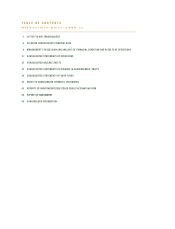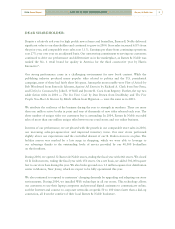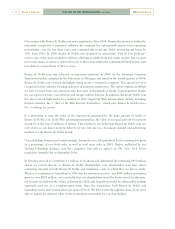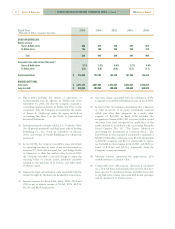Barnes and Noble 2004 Annual Report Download - page 11
Download and view the complete annual report
Please find page 11 of the 2004 Barnes and Noble annual report below. You can navigate through the pages in the report by either clicking on the pages listed below, or by using the keyword search tool below to find specific information within the annual report.
1Based upon sales reported in trade publications and public filings.
9
2004 Annual Report ■Barnes & Noble, Inc.
MANAGEMENT’S DISCUSSION AND ANALYSIS
OF FINANCIAL CONDITION AND RESULTS
OF OPERATIONS
Barnes & Noble, Inc.’s (Barnes & Noble or the
Company) fiscal year is comprised of 52 or 53 weeks,
ending on the Saturday closest to the last day of
January. As used in this section, “fiscal 2005”
represents the 52 weeks ending January 28, 2006,
“fiscal 2004” represents the 52 weeks ended January
29, 2005, “fiscal 2003” represents the 52 weeks ended
January 31, 2004 and “fiscal 2002” represents the 52
weeks ended February 1, 2003.
RESTATEMENT OF FINANCIAL STATEMENTS
As a result of a recent clarification from the Securities
and Exchange Commission, the Company re-evaluated
its lease accounting policies. Like many other
companies within the retail industry that corrected
commonly accepted lease accounting practices, the
Company has changed the way it accounts for its
leases, including the accounting for tenant allowances
and rent holidays during the store build-out period. As
a result of its review, the Company has corrected its
lease accounting policies in fiscal 2004, and while it
does not consider such corrections to be material to
any one year, has restated certain historical financial
information for prior periods. The restatement
adjustments are non-cash and had no impact on
revenues or total cash flows.
Consistent with common retail industry practice, the
Company had previously classified tenant allowances
received as a result of store openings as a reduction in
capital expenditures. The Company has reclassified
tenant allowances received from a reduction of fixed
assests to an increase in other long-term liabilities. The
related amortization of such amounts has been
reclassified from a reduction of depreciation expense to
a reduction of cost of sales and occupancy. Such
amortization reclassifications amounted to $32.1
million and $28.7 million in fiscal 2003 and
2002, respectively.
In addition, consistent with industry practice, the
Company had recognized the straight-line expense for
leases beginning on the earlier of the store opening date
or the commencement date of the lease, which had the
effect of excluding the construction period of its stores
from the calculation of the period over which it
expenses rent. In order to correct the straight-line rent
expense to include the store build-out period, in fiscal
2003 and 2002 the Company has decreased cost of sales
and occupancy and increased gross profit by $2.7
million and $2.6 million, respectively, decreased
operating profit and earnings before taxes and minority
interest by $0.1 million and $0.8 million, respectively,
and decreased net earnings by $0.1 million ($0.00 per
share) and $0.5 million ($0.01 per share), respectively.
The cumulative effect of such adjustments relating to
periods prior to fiscal 2002 amounting to $18.0 million,
has been recorded as a reduction of retained earnings as
of February 2, 2002. The Company also restated the
quarterly financial information for fiscal 2003 and the
first three quarters of fiscal 2004 (see Note 20 to the
Notes to Consolidated Financial Statements).
The January 31, 2004 balance sheet has been adjusted
to reflect the combined impact of the above re-
statements by increasing net property and equipment by
$225.0 million, increasing deferred rent (other long-
term liabilities) by $256.7 million, increasing deferred
tax assets by $13.2 million and decreasing retained
earnings and shareholders’ equity by $18.6 million.
GENERAL
The Company is the nation’s largest bookseller1, and as
of January 29, 2005 operates 820 bookstores. Of the
820 bookstores, 666 operate primarily under the Barnes
& Noble Booksellers trade name (32 of which were
opened in fiscal 2004) and 154 operate primarily under
the B. Dalton Bookseller trade name. Barnes & Noble
conducts the online part of its business through
barnesandnoble.com llc (Barnes & Noble.com), one of
the largest sellers of books on the Internet. Through
Sterling Publishing Co., Inc. (Sterling), the Company is
one of the top 25 publishers in the nation and the
industry’s leading publisher of how-to books. The
Company employed approximately 42,000 full- and
part-time employees as of January 29, 2005.
Barnes & Noble is the nation’s largest operator of
bookstores1with 666 Barnes & Noble stores located in
49 states and the District of Columbia as of January 29,
2005. With nearly 40 years of bookselling experience,
management has a strong sense of customers’ changing
needs and the Company leads book retailing with a
“community store” concept. Barnes & Noble’s typical
store offers a comprehensive title base, a café, a
children’s section, a music department, a magazine
section and a calendar of ongoing events, including
author appearances and children’s activities, that
make each Barnes & Noble store an active part of
its community.
























